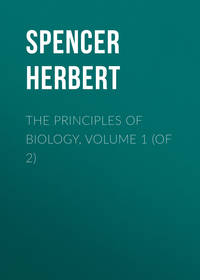 полная версия
полная версияFirst Principles
The sole truth which transcends experience by underlying it, is thus the persistence of Force. This being the basis of experience, must be the basis of any scientific organization of experiences. To this an ultimate analysis brings us down; and on this a rational synthesis must build up.
CHAPTER IX.
THE CORRELATION AND EQUIVALENCE OF FORCES
§ 77. When, to the unaided senses, Science began to add supplementary senses in the shape of measuring instruments, men began to perceive various phenomena which eyes and fingers could not distinguish. Of known forms of force, minuter manifestations became appreciable; and forms of force before unknown were rendered cognizable and measurable. Where forces had apparently ended in nothing, and had been carelessly supposed to have actually done so, instrumental observation proved that effects had in every instance been produced: the forces reappearing in new shapes. Hence there has at length arisen the inquiry whether the force displayed in each surrounding change, does not in the act of expenditure undergo metamorphosis into an equivalent amount of some other force or forces. And to this inquiry experiment is giving an affirmative answer, which becomes day by day more decisive. Grove, Helmholtz, and Meyer, are more than any others to be credited with the clear enunciation of this doctrine. Let us glance at the evidence on which it rests.
Motion, wherever we can directly trace its genesis, we find to pre-exist as some other mode of force. Our own voluntary acts have always certain sensations of muscular tension as their antecedents. When, as in letting fall a relaxed limb, we are conscious of a bodily movement requiring no effort, the explanation is that the effort was exerted in raising the limb to the position whence it fell. In this case, as in the case of an inanimate body descending to the Earth, the force accumulated by the downward motion is just equal to the force previously expended in the act of elevation. Conversely, Motion that is arrested produces, under different circumstances, heat, electricity, magnetism, light. From the warming of the hands by rubbing them together, up to the ignition of a railway-brake by intense friction – from the lighting of detonating powder by percussion, up to the setting on fire a block of wood by a few blows from a steam-hammer; we have abundant instances in which heat arises as Motion ceases. It is uniformly found, that the heat generated is great in proportion as the Motion lost is great; and that to diminish the arrest of motion, by diminishing the friction, is to diminish the quantity of heat evolved. The production of electricity by Motion is illustrated equally in the boy’s experiment with rubbed sealing-wax, in the common electrical machine, and in the apparatus for exciting electricity by the escape of steam. Wherever there is friction between heterogeneous bodies, electrical disturbance is one of the consequences. Magnetism may result from Motion either immediately, as through percussion on iron, or mediately as through electric currents previously generated by Motion. And similarly, Motion may create light; either directly, as in the minute incandescent fragments struck off by violent collisions, or indirectly, as through the electric spark. “Lastly, Motion may be again reproduced by the forces which have emanated from Motion; thus, the divergence of the electrometer, the revolution of the electrical wheel, the deflection of the magnetic needle, are, when resulting from frictional electricity, palpable movements reproduced by the intermediate modes of force, which have themselves been originated by motion.”
That mode of force which we distinguish as Heat, is now generally regarded by physicists as molecular motion – not motion as displayed in the changed relations of sensible masses to each other, but as occurring among the units of which such sensible masses consist. If we cease to think of Heat as that particular sensation given to us by bodies in certain conditions, and consider the phenomena otherwise presented by these bodies, we find that motion, either in them or in surrounding bodies, or in both, is all that we have evidence of. With one or two exceptions which are obstacles to every theory of Heat, heated bodies expand; and expansion can be interpreted only as a movement of the units of a mass in relation to each other. That so-called radiation through which anything of higher temperature than things around it, communicates Heat to them, is clearly a species of motion. Moreover, the evidence afforded by the thermometer that Heat thus diffuses itself, is simply a movement caused in the mercurial column. And that the molecular motion which we call Heat, may be transformed into visible motion, familiar proof is given by the steam-engine; in which “the piston and all its concomitant masses of matter are moved by the molecular dilatation of the vapour of water.” Where Heat is absorbed without apparent result, modern inquiries show that decided though unobtrusive changes are produced: as on glass, the molecular state of which is so far changed by heat, that a polarized ray of light passing through it becomes visible, which it does not do when the glass is cold; or as on polished metallic surfaces, which are so far changed in structure by thermal radiations from objects very close to them, as to retain permanent impressions of such objects. The transformation of Heat into electricity, occurs when dissimilar metals touching each other are heated at the point of contact: electric currents being so induced. Solid, incombustible matter introduced into heated gas, as lime into the oxyhydrogen flame, becomes incandescent; and so exhibits the conversion of Heat into light. The production of magnetism by Heat, if it cannot be proved to take place directly, may be proved to take place indirectly through the medium of electricity. And through the same medium may be established the correlation of Heat and chemical affinity – a correlation which is indeed implied by the marked influence that Heat exercises on chemical composition and decomposition.
The transformations of Electricity into other modes of force, are still more clearly demonstrable. Produced by the motion of heterogeneous bodies in contact, Electricity, through attractions and repulsions, will immediately reproduce motion in neighbouring bodies. Now a current of Electricity generates magnetism in a bar of soft iron; and now the rotation of a permanent magnet generates currents of Electricity. Here we have a battery in which from the play of chemical affinities an electric current results; and there, in the adjacent cell, we have an electric current effecting chemical decomposition. In the conducting wire we witness the transformation of Electricity into heat; while in electric sparks and in the voltaic arc we see light produced. Atomic arrangement, too, is changed by Electricity: as instance the transfer of matter from pole to pole of a battery; the fractures caused by the disruptive discharge; the formation of crystals under the influence of electric currents. And whether, conversely, Electricity be or be not directly generated by re-arrangement of the atoms of matter, it is at any rate indirectly so generated through the intermediation of magnetism.
How from Magnetism the other physical forces result, must be next briefly noted – briefly, because in each successive case the illustrations become in great part the obverse forms of those before given. That Magnetism produces motion is the ordinary evidence we have of its existence. In the magneto-electric machine we see a rotating magnet evolving electricity. And the electricity so evolved may immediately after exhibit itself as heat, light, or chemical affinity. Faraday’s discovery of the effect of Magnetism on polarized light, as well as the discovery that change of magnetic state is accompanied by heat, point to further like connexions. Lastly, various experiments show that the magnetization of a body alters its internal structure; and that conversely, the alteration of its internal structure, as by mechanical strain, alters its magnetic condition.
Improbable as it seemed, it is now proved that from Light also may proceed the like variety of agencies. The solar rays change the atomic arrangements of particular crystals. Certain mixed gases, which do not otherwise combine, combine in the sunshine. In some compounds Light produces decomposition. Since the inquiries of photographers have drawn attention to the subject, it has been shown that “a vast number of substances, both elementary and compound, are notably affected by this agent, even those apparently the most unalterable in character, such as metals.” And when a daguerreotype plate is connected with a proper apparatus “we get chemical action on the plate, electricity circulating through the wires, magnetism in the coil, heat in the helix, and motion in the needles.”
The genesis of all other modes of force from Chemical Action, scarcely needs pointing out. The ordinary accompaniment of chemical combination is heat; and when the affinities are intense, light also is, under fit conditions, produced. Chemical changes involving alteration of bulk, cause motion, both in the combining elements and in adjacent masses of matter: witness the propulsion of a bullet by the explosion of gunpowder. In the galvanic battery we see electricity resulting from chemical composition and decomposition. While through the medium of this electricity, Chemical Action produces magnetism.
These facts, the larger part of which are culled from Mr. Grove’s work on “The Correlation of Physical Forces,” show us that each force is transformable, directly or indirectly, into the others. In every change Force undergoes metamorphosis; and from the new form or forms it assumes, may subsequently result either the previous one or any of the rest, in endless variety of order and combination. It is further becoming manifest that the physical forces stand not simply in qualitative correlations with each other, but also in quantitative correlations. Besides proving that one mode of force may be transformed into another mode, experiments illustrate the truth that from a definite amount of one, definite amounts of others always arise. Ordinarily it is indeed difficult to show this; since it mostly happens that the transformation of any force is not into some one of the rest but into several of them: the proportions being determined by the ever-varying conditions. But in certain cases, positive results have been reached. Mr. Joule has ascertained that the fall of 772 lbs. through one foot, will raise the temperature of a pound of water one degree of Fahrenheit. The investigations of Dulong, Petit and Neumann, have proved a relation in amount between the affinities of combining bodies and the heat evolved during their combination. Between chemical action and voltaic electricity, a quantitative connexion has also been established: Faraday’s experiments implying that a specific measure of electricity is disengaged by a given measure of chemical action. The well-determined relations between the quantities of heat generated and water turned into steam, or still better the known expansion produced in steam by each additional degree of heat, may be cited in further evidence. Whence it is no longer doubted that among the several forms which force assumes, the quantitative relations are fixed. The conclusion tacitly agreed on by physicists, is, not only that the physical forces undergo metamorphoses, but that a certain amount of each is the constant equivalent of certain amounts of the others.
§ 78. Throughout Evolution under all its phases, this truth of course invariably holds. Every successive change or group of changes forming part of it, is of necessity limited by the conditions thus implied. The forces which any step in Evolution exhibits, must be affiliable on the like or unlike forces previously existing; while from the forces so generated must thereafter be derived others more or less transformed. And besides recognizing the forces at any time existing, as necessarily linked with those preceding and succeeding them, we must also recognize the amounts of these forces successively manifested as determinate, – as necessarily producing such and such quantities of results, and as necessarily limited to those quantities.
Involved as are the phenomena of Evolution, it is not to be expected that a definite quantitative relation can in each case, or indeed in any case, be shown between the forces expended in successive phases. We have not adequate data for this; and probably shall never have them. The antecedents of the simpler forms of Evolution, belong to a remote past respecting which we can have nothing but inferential knowledge; while the antecedents of the only kind of Evolution which is traceable from beginning to end (namely, that of individual organisms) are too complex to be dealt with by exact methods. Hence we cannot hope to establish equivalence among the successive manifestations of force which each order of Evolution affords. The most we can hope is to establish a qualitative correlation that is indefinitely quantitative – quantitative in so far as involving something like a due proportion between causes and effects. If this can be done, however, some progress will be made towards the solution of our problem. Though it may be beyond our power to show a measurable relation between the force or group of forces which any phase of Evolution displays, and the force or group of forces immediately succeeding it; yet if we can show that there always are antecedent forces, and that the effects they produce always become the antecedents of further ones – if while unable to calculate how much of each change will be produced, we can prove that a change of that kind was necessitated – if we can discern even the vaguest correspondence between the amount of such change and the amount of the pre-existing force; we shall advance a step towards interpreting the transformation of the simple into the complex.
With the view of attempting this, let us now reconsider the different types of Evolution awhile since delineated: taking them in the same order as before.
§ 79. On contemplating our Solar System the first fact which strikes us, is, that all its members are in motion; and that their motion is of a two-fold, or rather of a three-fold, kind. Each planet and satellite has a movement of rotation and a movement of translation; besides the movement through space which all have in common with their rotating primary. Whence this unceasing change of place?
The hypothesis of Evolution supplies us with an answer. Impossible as it is to assign a reason for the pre-existence of matter in the diffused form supposed; yet assuming its pre-existence in that form, we have in the gravitation of its parts a cause of motion adequate to the results. So far too as the evidence carries us, we can perceive some quantitative relation between the motions produced, and the gravitative forces expended in producing them. The planets formed from that matter which has travelled the shortest distance towards the common centre of gravity, have the smallest velocities: the uniform law being that in advancing from the outermost to the innermost planets, the rate of orbital motion progressively increases. It may indeed be remarked that this is explicable on the teleological hypothesis; since it is a condition to equilibrium. But without dwelling on the fact that this is beside the question, it will suffice to point out that the like cannot be said of the planetary rotations. No such final cause can be assigned for the rapid axial movement of Jupiter and Saturn, or the slow axial movement of Mercury. But if in pursuance of the doctrine of correlation we look for the antecedents of these gyrations which all planets exhibit, the theory of Evolution furnishes us with equivalent ones; and ones which bear manifest quantitative relations to the motions displayed. For the planets that turn on their axes with extreme rapidity, are those having great masses and large orbits – those, that is, of which the once diffused elements moved to their centres of gravity through immense spaces, and so acquired high velocities. While, conversely, there has resulted the smallest axial movement where the orbit and the mass are both the smallest.
“But what,” it may be asked, “has in such case become of all that motion which brought about the aggregation of this diffused matter into solid bodies?” The rotation of each body can be but a residuary result of concentration – a result due to the imperfect balancing of gravitative movements from opposite points towards the common centre. Such gravitative movements from opposite points must in great measure destroy each other. What then has become of these mutually-destroyed motions? The answer which the doctrine of correlation suggests is – they must have been radiated in the form of heat and light. And this answer the evidence, so far as it goes, confirms. Apart from any speculation respecting the genesis of the solar system, the inquiries of geologists lead to the conclusion that the heat of the Earth’s still molten nucleus is but a remnant of the heat which once made molten the entire Earth. The mountainous surfaces of the Moon and of Venus (which alone are near enough to be scrutinized), indicating, as they do, crusts that have, like our own, been corrugated by contraction, imply that these bodies too have undergone refrigeration – imply in each of them a primitive heat, such as the hypothesis necessitates. Lastly, we have in the Sun a still-continued production of this heat and light, which must result from the arrest of diffused matter moving towards a common centre of gravity. Here also, as before, a quantitative relation is traceable. Among the bodies which make up the Solar System, those containing comparatively small amounts of matter whose centripetal motion has been destroyed, have already lost nearly all the produced heat: a result which their relatively larger surfaces have facilitated. But the Sun, a thousand times as great in mass as the largest planet, and having therefore to give off an enormously greater quantity of heat and light due to arrest of moving matter, is still radiating with great intensity.
Thus we see that when, in pursuance of the doctrine of correlation, we ask whence come the forces which our Solar System displays, the hypothesis of Evolution gives us a proximate explanation. If the Solar System once existed in a state of indefinite, incoherent homogeneity, and has progressed to its present state of definite, coherent heterogeneity; then the Motion, Heat, and Light now exhibited by its members, are interpretable as the correlatives of pre-existing forces; and between them and their antecedents we may discern relations that are not only qualitative, but also rudely quantitative. How matter came to exist under the form assumed, is a mystery which we must regard as ultimate. But grant such a previous form of existence, and the hypothesis of Evolution interpreted by the laws of correlation, explains for us the forces as we now see them.
§ 80. If we inquire the origin of those forces which have wrought the surface of our planet into its present shape, we find them traceable to the same primordial source as that just assigned. Assuming the solar system to have been evolved, then geologic changes are either direct or indirect results of the unexpended heat caused by nebular condensation. These changes are commonly divided into igneous and aqueous: – heads under which we may most conveniently consider them.
All those periodic disturbances which we call earthquakes, all those elevations and subsidences which they severally produce, all those accumulated effects of many such elevations and subsidences exhibited in ocean-basins, islands, continents, table-lands, mountain-chains, and all those formations which are distinguished as volcanic, geologists now regard as modifications of the Earth’s crust produced by the still-molten matter occupying its interior. However untenable may be the details of M. Elie de Beaumont’s theory, there is good reason to accept the general proposition that the disruptions and variations of level which take place at intervals on the terrestrial surface, are due to the progressive collapse of the Earth’s solid envelope upon its cooling and contracting nucleus. Even supposing that volcanic eruptions, extrusions of igneous rock, and upheaved mountain-chains, could be otherwise satisfactorily accounted for, which they cannot; it would be impossible otherwise to account for those wide-spread elevations and depressions whence continents and oceans result. The conclusion to be drawn is, then, that the forces displayed in these so-called igneous changes, are derived positively or negatively from the unexpended heat of the Earth’s interior. Such phenomena as the fusion or agglutination of sedimentary deposits, the warming of springs, the sublimation of metals into the fissures where we find them as ores, may be regarded as positive results of this residuary heat; while fractures of strata and alterations of level are its negative results, since they ensue on its escape. The original cause of all these effects is still, however, as it has been from the first, the gravitating movement of the Earth’s matter towards the Earth’s centre; seeing that to this is due both the internal heat itself and the collapse which takes place as it is radiated into space.
When we inquire under what forms previously existed the force which works out the geological changes classed as aqueous, the answer is less obvious. The effects of rain, of rivers, of winds, of waves, of marine currents, do not manifestly proceed from one general source. Analysis, nevertheless, proves to us that they have a common genesis. If we ask, – Whence comes the power of the river-current, bearing sediment down to the sea? the reply is, – The gravitation of water throughout the tract which this river drains. If we ask, – How came the water to be dispersed over this tract? the reply is, – It fell in the shape of rain. If we ask, – How came the rain to be in that position whence it fell? the reply is, – The vapour from which it was condensed was drifted there by the winds. If we ask, – How came this vapour to be at that elevation? the reply is, – It was raised by evaporation. And if we ask, – What force thus raised it? the reply is, – The sun’s heat. Just that amount of gravitative force which the sun’s heat overcame in raising the atoms of water, is given out again in the fall of those atoms to the same level. Hence the denudations effected by rain and rivers, during the descent of this condensed vapour to the level of the sea, are indirectly due to the sun’s heat. Similarly with the winds that transport the vapours hither and thither. Consequent as atmospheric currents are on differences of temperature (either general, as between the equatorial and polar regions, or special as between tracts of the Earth’s surface of unlike physical characters) all such currents are due to that source from which the varying quantities of heat proceed. And if the winds thus originate, so too do the waves raised by them on the sea’s surface. Whence it follows that whatever changes waves produce – the wearing away of shores, the breaking down of rocks into shingle, sand, and mud – are also traceable to the solar rays as their primary cause. The same may be said of ocean-currents. Generated as the larger ones are by the excess of heat which the ocean in tropical climates continually acquires from the Sun; and generated as the smaller ones are by minor local differences in the quantities of solar heat absorbed; it follows that the distribution of sediment and other geological processes which these marine currents effect, are affiliable upon the force which the sun radiates. The only aqueous agency otherwise originating is that of the tides – an agency which, equally with the others, is traceable to unexpended astronomical motion. But making allowance for the changes which this works, we reach the conclusion that the slow wearing down of continents and gradual filling up of seas, by rain, rivers, winds, waves, and ocean-streams, are the indirect effects of solar heat.
Thus the implication forced on us by the doctrine of correlation, that the forces which have moulded and re-moulded the Earth’s crust must have pre-existed under some other shape, is quite in conformity with the theory of Evolution; since this pre-supposes certain forces that are both adequate to the results, and cannot be expended without producing the results. We see that while the geological changes classed as igneous, result from the still-progressing motion of the Earth’s substance to its centre of gravity; the antagonistic changes classed as aqueous, result from the still-progressing motion of the Sun’s substance towards its centre of gravity – a motion which, transformed into heat and radiated to us, is here re-transformed, directly into motions of the gaseous and liquid matters on the Earth’s surface, and indirectly into motions of the solid matters.









